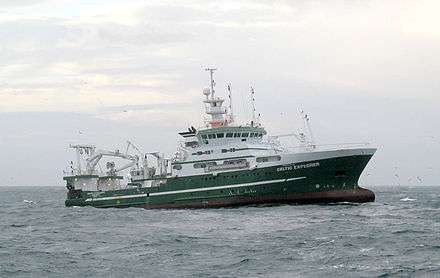Hákarl
Kæstur hákarl (Icelandic pronunciation: [ˈhauːkʰartl̥]) (Icelandic for "fermented shark") is a national dish of Iceland consisting of a Greenland shark (Somniosus microcephalus) or other sleeper shark which has been cured with a particular fermentation process and hung to dry for four to five months. Kæstur hákarl has a strong ammonia-rich smell and fishy taste.[1]
Kæstur hákarl is readily available in Icelandic stores and is eaten year-round, but is also served as part of a þorramatur, a selection of traditional Icelandic food served at þorrablót in midwinter.
Consumption
Kæstur hákarl contains a large amount of ammonia and has a strong smell, similar to many cleaning products. It is often served in cubes on toothpicks. Those new to it may gag involuntarily on the first attempt to eat it because of the high ammonia content.[1] First-timers are sometimes advised to pinch their nose while taking the first bite, as the smell is much stronger than the taste. It is often eaten with a shot of the local spirit, a type of akvavit called brennivín.
It comes in two varieties; chewy and reddish glerhákarl (lit. "glassy shark") from the belly, and white and soft skyrhákarl (lit. "skyr shark") from the body.
Preparation
The meat of the Greenland shark is poisonous when fresh, due to a high content of urea and trimethylamine oxide, but may be consumed after being processed.[2][3]
The traditional method is by gutting and beheading a Greenland or sleeper shark and placing it in a shallow hole dug in gravelly sand, with the now cleaned cavity resting on a small mound of sand. The shark is then covered with sand and gravel, and stones are placed on top of the sand in order to press the shark. In this way the fluids are pressed out of the body. The shark ferments in this fashion for 6–12 weeks depending on the season. Following this curing period, the shark is then cut into strips and hung to dry for several months. During this drying period a brown crust will develop, which is removed prior to cutting the shark into small pieces and serving.
It is possible to witness the traditional preparation process at Bjarnarhöfn Shark Museum on Snæfellsnes.[4]
The modern method is just to press the shark's meat in a large drained plastic container.[5]
Reactions from outside Iceland
Chef Anthony Bourdain described kæstur hákarl as "the single worst, most disgusting and terrible tasting thing" he has ever eaten.[1]
Chef Gordon Ramsay challenged James May to sample three "delicacies" (Laotian snake whiskey, bull penis, and kæstur hákarl) on The F Word; after eating kæstur hákarl, Ramsay spat it out, but May was able to keep his down. May even offered to eat it again.[6]
On season two's Iceland episode of Travel Channel's Bizarre Foods with Andrew Zimmern, Andrew Zimmern described the smell as reminding him of "some of the most horrific things I've ever breathed in my life," but said it tasted much better than it smelled. He described the taste as "sweet, nutty and only faintly fishy." Nonetheless, he did note of kæstur hákarl: "That's hardcore. That's serious food. You don't want to mess with that. That's not for beginners."
In one of season five's final episodes of Animal Planet's River Monsters, Biologist and Angler Jeremy Wade mentions that the flesh "smells of urine" that has "a really strong aftertaste, it really kicks in. It really kicks in at the back of the throat after you take the first bite." He further states that the meat was really unlike anything he's tried before; that it is like really strong cheese but with a definite fish element.
Archaeologist Neil Oliver tasted it in the BBC documentary Vikings as part of examining the Viking diet. He described it as reminiscent of "blue cheese but a hundred times stronger".
Chef Ainsley Harriott, during his series Ainsley Eats the Streets, was unable to handle the heavy ammonia taste and described it as "like chewing a urine-infested mattress".
See also
References
- 1 2 3 Herz, Rachel (28 January 2012). "You eat that?". Wall Street Journal. Archived from the original on 17 March 2015. Retrieved 30 January 2012.
- ↑ "Somniosus microcephalus :: Florida Museum of Natural History".
- ↑ Yuen, David. "The Mystery of Hakarl: Rotten Shark Meat Delicacy From Iceland". Archived from the original on 2013-10-29.
- ↑ Bjarnarhöfn Shark Museum.
- ↑ Wheatley, Gale (20 September 2010). "Iceland's Wild Culinary Traditions: Hákarl and Brennivín".
- ↑ "Gordon Ramsay vs. James May", The F-Word
External links
- Durst, Sidra (2012). "Hákarl". In Deutsch, Jonathan; Murakhver, Natalya. They Eat That? A Cultural Encyclopedia of Weird and Exotic Food from around the World: A Cultural Encyclopedia of Weird and Exotic Food from around the World. pp. 91–2. ISBN 978-0-313-38059-4.
- Kæstur hákarl prepared by an Icelandic cook
- Jo's Icelandic Recipes: How to prepare "Rotten" Shark: How to Prepare Rotten Shark, Retrieved Sept. 14, 2006.
- ″Nordics Like Fish″ cartoon, from Scandinavian and the World comics. Describes the differences between odd fish cuisine of the Nordic countries in a humorous way.
